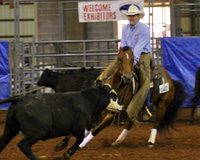When it comes to riding a horse, using a bit is standard fare. But a bit is not the only way to send messages to your horse through the reins. Western riders have been using hackamores—a type of bitless bridles—for many years.
Two kinds of basic hackamores are available on the market: the bosal and the mechanical.

Bosal Hackamore
Although this hackamore is commonly referred to simply as a “bosal,” it is technically just the nosepiece that goes by that name. The bosal nosepiece is typically made from braided rawhide, and has a teardrop shape. A large knot at the bottom of the bosal goes under the horse’s chin and attaches to the reins. A mecate rope is also often attached to the bosal, and is typically made of horsehair. The mecate is separate from the reins, and can be used as a lead rope.
A bosal, when properly fitted, works by putting pressure in the horse’s nose and jaw when the reins are used. When the reins are not engaged, the bosal rests in a neutral position.
California vaqueros first used bosals back in the 1800s when working cattle on horseback. This hackamore is still used by riders who train in the old vaquero style, as well as many western riders who like the feel of riding in a bosal. Some western competitive events also feature bosals.
Mechanical Hackamore
The mechanical hackamore earned its name because, unlike the bosal, it uses a metal, mechanical nosepiece. Mechanical hackamores come in different styles, with everything from flat leather to covered bicycle chains for nosebands. These hackmores also feature metal shanks that work to keep the horse’s nose down, along with a curb chain under the chin. The shanks can vary in length from short to very long, and have reins attached.
Mechanical hackamores work by putting pressure on the horse’s nose and jaw when the reins are used. When the reins are relaxed, the mechanical hackamore should rest on the horse’s face in a neutral position.
The mechanical hackamore came into use in the U.S. among western riders back in the 1930s. It is commonly seen on horses used for trail riding, and in some western competitions.
Hackamores don’t use a bit, but that doesn’t make them any less severe in the wrong hands. If you are going to ride in a hackamore, you need to know how to use it in a way that won’t hurt your horse. A heavy handed rider can do a lot of damage to a horse’s nose with a hackamore. Before you switch your bit for a hackamore, make sure you know how to ride with light hands.
When properly used, a hackamore can give a horse plenty of freedom to drink and graze along the trail, or to just relax on a short trail ride close to home. If you’d like to switch from a bit to a hackamore, get help from an experienced horseperson who can help you get just the right fit for your horse.








Thank you (HC) for another useful article.
You completely ignore the fiadore. Without it, the heel pf the bosal drops against the chin. When a signal given, the heel of the bosal has to be raised to make even light contact with the jaw and nose. The result is that it takes a mili-second or two for the horse to get the signal. A “sloppy” signal produces a “sloppy response. A bosal should fit around the nose exactly like a hat. If it does, the horse can feel a signal by simply wiggling a rein. A pull is not required when a bosal fits correctly. I have been training bridle horses since I was 30 (over 50 years ago) and know whereof I speak. I am currently in the process of starting a 3 year old Arabian gelding that is going to eventually make a superb bridle horse..